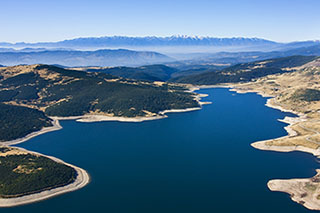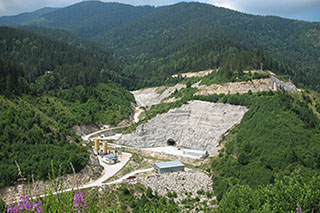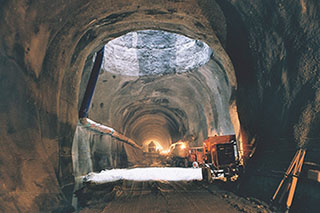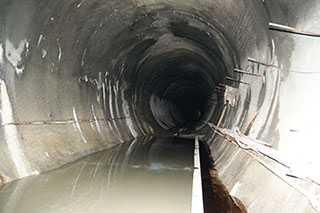
Project name: Hydro-pumped storage in Bulgaria - Yadenitsa
Project description:
 |
YA_2018-02-02_Brochure |
In pursuance to the EU Directives, in particular the third liberalization package, in the last years a lot changes occurred in the energy strategy and in the electricity sector development plan, mainly directed towards the following:
1. Priority development of electricity generation from renewable energy sources (RES), which has resulted in the necessity of additional quick reserve for these capacities balancing and replacing.
2. Continuing the liberalization process in the electric power sector in the country and in the Region, establishment of a balancing market and a market for services provision.
3. Increasing the requirements for security of supplies.
This has resulted in the need of implementation of the Project for increasing the volume of the lower reservoir of Chaira PSHPP by the construction of Yadenitsa Dam and a construction of a reversible tunnel connecting the new dam to the existing dam of the power plant ("Project").
Ensuring of safe, secure and economic electric power supply at permissible voltage and frequency levels is a main leading principle in the electric power system control. Therefore, the participation of Chaira PSHPP in the generating capacities that provide power supply balancing in various scenarios of electricity demand, load curves and other factors can be defined as determining from a system point of view within the country and the region.
With 864 MW in a generating mode and 788 MW in a pumping mode, Chaira PSHPP is the biggest pump-storage hydro power plant in Southeast Europe. It has four hydro units - each of them of 216 MW in a generating mode and 197 MW in a pumping mode. The upper reservoir of Chaira PSHPP is Belmeken Dam which has usable volume of 141 mln. m3 and is also the main water storage for the power plants of Belmeken-Sestrimo Hydro Power Cascade, and the lower reservoir is Chaira Dam which has usable volume of 4.2 mln. m3. Hydro units 1 and 2 of the power plant have been in operation since 1995, and hydro units 3 and 4 - since 1999.
As it can be seen from the data mentioned above, Chaira PSHPP has one big upper reservoir and one very small lower reservoir. This considerably constrains the plant's operational time span and respectively imposes certain limits on the power plant operation. At the same time the changes in the energy sector and the requirements for greater usage of environmentally friendly renewable energy sources increase the necessity of balancing capacities.
The Project is part of the Ten-Year Network Development Plan 2014 (TYNDP) of the European Network of Transmission System Operators for Electricity (ENTSO-E) and can be found in the Regional Investment Plan Continental South East published on ENTSO-E website with the TYNDP 2014 full report under project index 218 – more info at: www.entsoe.eu/major-projects/ten-year-network-development-plan/tyndp-2014/Pages/default.aspx.
The main benefits justifying the necessity of Yadenitsa Dam construction are related with the possibility of Chaira PSHPP switching from a daily to a weekly operating mode, thus increasing its use.
In the daily operating mode it is necessary to have an everyday balance of the waters processed by the power plant in a turbine and in a pumping mode. It should be noted that the available volume of Chaira Dam allows operation at full capacity in a turbine mode for 8,5 hours and in a pumping mode - for 10,7 hours. The increased volume of the lower reservoir of Chaira PSHPP by the Project implementation will make it possible to switch to a weekly operating mode, during which the four hydro units of the power plant will be able to operate at full capacity in a turbine mode for 20 hours and in pump mode for 22,5 hours.
The economic effect resulting from the project implementation is expressed in reducing the total system costs and increasing the security of power supply in the following areas:
1. Improving the structure of generating capacities, mainly in NPP and TPP and increasing their efficiency.
The increased generation potential of Chaira PSHPP if Yadenitsa dam is built, will allow greater flexibility of the capacities that participate in load covering, which will result in engagement of the more efficient power plants, while the other power plants will remain as cold reserve.
The increased potential of Chaira PSHPP will also allow increasing of the base load part in the load diagram, which will provide permanent round-the-clock operation of NPP and TPP at optimal efficiency. The fluctuations in the loading of the most maneuverable TPP capacities, as well as the number of their switching-on/off during weekends and holidays will be reduced on the account of additional loading of Chaira PSHPP in a generating/pumping mode. The same as so far, Chaira PSHPP together with the installed capacities in the HPPs will participate in covering of peak loads in the load diagram.
2. Improving the structure of back-up capacity.
Considerable generating capacity of 864 MW focused at one place, minimum time for complete loading, high automation degree of the operating modes control and lack of limitations related with the volume of the upper reservoir are conditions required for Chaira PSHPP so that it can play the role of emergency back-up in the Electric Power System (when base load capacities fail, including 1000 MW in Kozloduy NPP).
The only condition that the power plant hasn't met so that it can perform that function presently is the small volume of the lower reservoir. The feasibility study prepared in 1996 makes a detailed energy and hydraulic analysis, which proves that the construction of Yadenitsa Dam will remove that last obstacle.
3. Role of Chaira PSHPP in the conditions of an increasing relative share of RES generating capacities and highly efficient cogeneration of electricity and heat energy.
For the last years in the whole world, as well as in Bulgaria, we have observed a quick growth of installed RES generating capacities and capacities of highly efficient cogeneration of electric power and heat energy, and the forecasts envisage further increase of their share. The unpredictability of this type of primary energy sources and their impossibility to be self-balanced create significant difficulties in the capacities control for meeting the loads in the system and such difficulties are expected to increase in parallel with the electricity generated from RES.
Therefore, it becomes necessary to provide for these capacities additional highly flexible balancing back-up capacities (doubling capacities) which can meet the needs of generating capacities depending on the fluctuations related with the RES power plants operation. A possible solution of this problem is to increase the generating capacity of Chaira PSHPP by the construction of Yadenitsa Dam.
Contact details of project promoter:
Natsionalna Elektricheska Kompania EAD,
Project Management Department – email: This email address is being protected from spambots. You need JavaScript enabled to view it., fax: +3592 9861 288.
Information on planned public consultations:
At this stage of the project no public consultations are scheduled.







